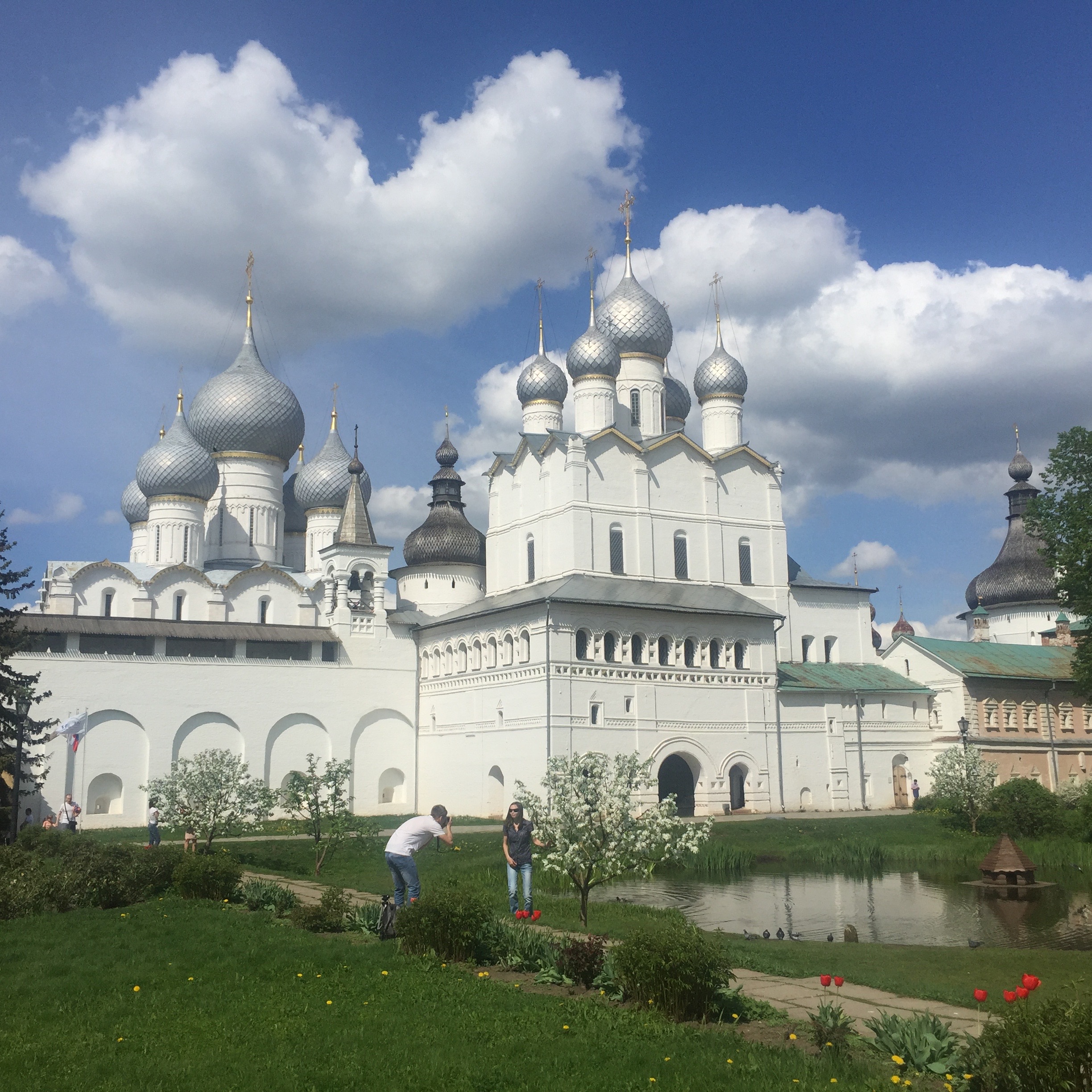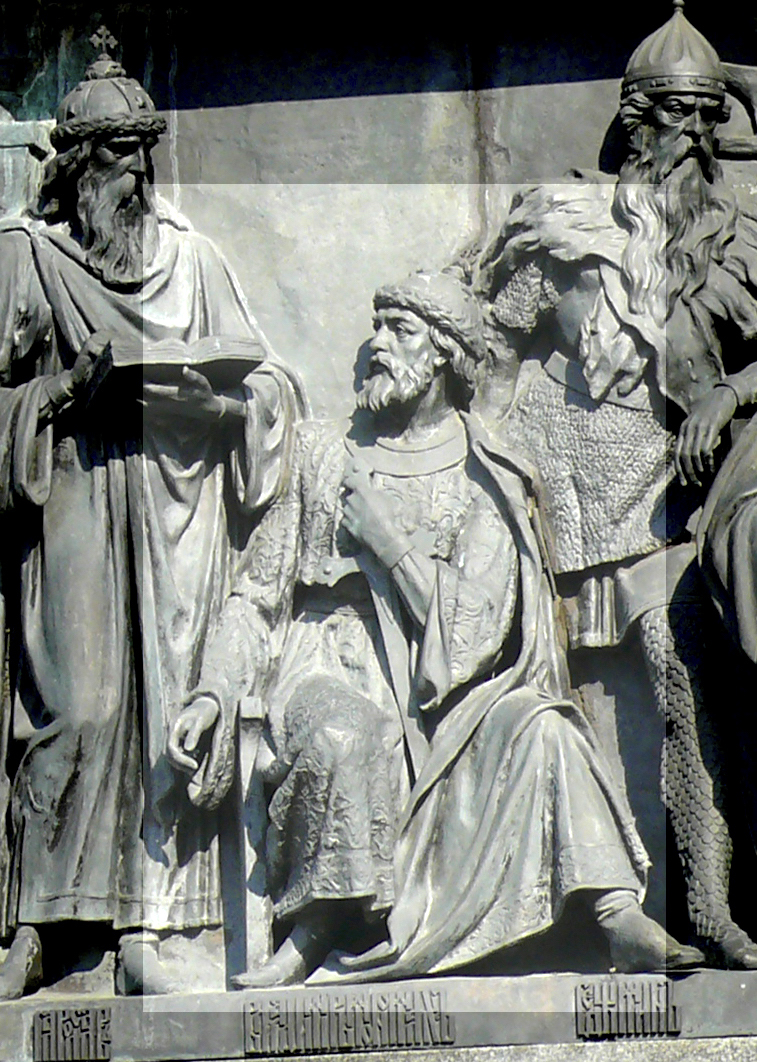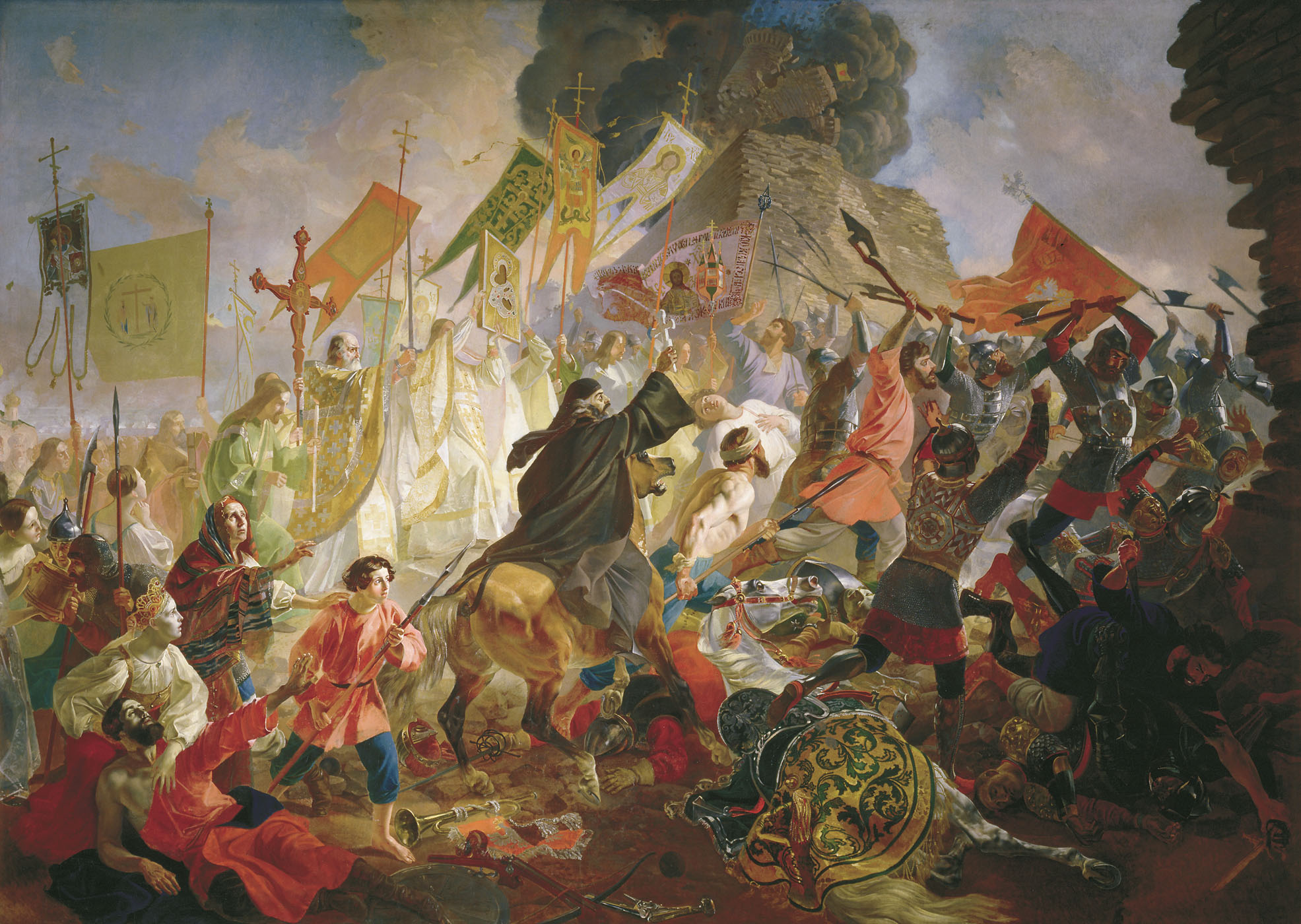|
Yaropolk II Of Kiev
Yaropolk II Vladimirovich Monomakh (russian: Ярополк II Владимирович, uk, Ярополк II Володимирович) (1082 – 18 February 1139), Prince of Pereiaslav (1114–1132), (Grand Prince) of Kiev (1132–1139), son of Vladimir II Monomakh and Gytha of Wessex. He fought in several campaigns against the Cumans, once in 1103 and again in 1116. After the death of his brother in 1132, Msitslav I the Great, Yaropolk received the crown of Kiev. Yaropolk had to deal with the many interests of his family, most of all his powerful half brother Yuri Dolgoruki. Yaropolk appointed Vsevolod Mstislavich to succeed him in Pereiaslav but Yuri Dolgoruki, with the consent of the Novgorodians, soon drove out his nephew. Yaropolk appointed another son of Mstislav I: Iziaslav Mstislavich to Pereyaslav, who also received Turov. He was replaced soon thereafter by Yaropolk's brother Viacheslav Vladimirovich. The peace didn't last long and in 1134 the merry-go-round star ... [...More Info...] [...Related Items...] OR: [Wikipedia] [Google] [Baidu] |
Rurik Dynasty
The Rurik dynasty ( be, Ру́рыкавічы, Rúrykavichy; russian: Рю́риковичи, Ryúrikovichi, ; uk, Рю́риковичі, Riúrykovychi, ; literally "sons/scions of Rurik"), also known as the Rurikid dynasty or Rurikids, was a noble lineage founded by the Varangian prince Rurik, who established himself in Novgorod around the year AD 862. The Rurikids were the ruling dynasty of Kievan Rus' (after the conquest of Kiev by Oleg of Novgorod in 882) before it finally disintegrated in the mid-13th century, as well as the successor Rus' principalities and Rus' prince republics of Novgorod, Pskov, Vladimir-Suzdal, Ryazan, Smolensk, Galicia-Volhynia (after 1199), Chernigov, and the Grand Duchy of Moscow (from 1263). Following the disintegration of Kievan Rus', the most powerful state to eventually arise was the Grand Duchy of Moscow, initially a part of Vladimir-Suzdal, which, along with the Novgorod Republic, established the basis of the modern Russian natio ... [...More Info...] [...Related Items...] OR: [Wikipedia] [Google] [Baidu] |
Rostov
Rostov ( rus, Росто́в, p=rɐˈstof) is a town in Yaroslavl Oblast, Russia, one of the oldest in the country and a tourist center of the Golden Ring. It is located on the shores of Lake Nero, northeast of Moscow. Population: While the official name of the town is Rostov, it is popularly known to Russians as Rostov Veliky ( rus, Ростов Великий, ''Rostov the Great'') to distinguish it from the much larger city of Rostov-on-Don. The name of the town railway station is Rostov Yaroslavsky, due to its location in Yaroslavl Oblast. History Rostov was preceded by Sarskoye Gorodishche, which some scholars interpret as the capital of the Finnic Merya tribe. Others believe it was an important Viking trade enclave and fortress guarding the Volga trade route. It is known from Norse sources as Raðstofa. Scythians also settled there. These different ethnicities, such as the Vikings, Scyths, Slavs and Finns, were likely the ancestors of many of today's people in that ... [...More Info...] [...Related Items...] OR: [Wikipedia] [Google] [Baidu] |
Yaroslav I The Wise
Yaroslav the Wise or Yaroslav I Vladimirovich; russian: Ярослав Мудрый, ; uk, Ярослав Мудрий; non, Jarizleifr Valdamarsson; la, Iaroslaus Sapiens () was the Grand Prince of Kiev from 1019 until his death. He was also the Prince of Novgorod on three occasions, uniting the principalities for a time. Yaroslav's baptismal name was George ( orv, Гюрьгi, ) after Saint George. Rise to the throne The early years of Yaroslav's life are mostly unknown. He was one of the numerous sons of Vladimir the Great, presumably his second by Rogneda of Polotsk, although his actual age (as stated in the ''Primary Chronicle'' and corroborated by the examination of his skeleton in the 1930s) would place him among the youngest children of Vladimir. It has been suggested that he was a child begotten out of wedlock after Vladimir's divorce from Rogneda and marriage to Anna Porphyrogenita, or even that he was a child of Anna Porphyrogenita herself. French historian Je ... [...More Info...] [...Related Items...] OR: [Wikipedia] [Google] [Baidu] |
Edith Swanneck
Edith the Fair ( ang, Ealdgȳð Swann hnesce, "Edyth the Gentle Swan"; c. 1025 – c. 1066), also known as Edith Swanneck,Her first name is also spelled Ealdgyth, Aldgyth, ''Edeva'' or Eddeva, and sometimes appears as ''Ēadgȳð'' and ''Ēadgifu''. (Compare ''Godgifu'' which was modified to ''Godiva'' in Latin texts.) one of the wealthiest magnates in England on the eve of the Norman conquest, may also have been the first wife of King Harold Godwinson. "Swanneck" (or Swan-Neck) comes from the folk etymology which made her in Old English as ''swann hnecca'', "swan neck", which was actually most likely a corrupted form of ''swann hnesce, ''"Gentle Swan"'' ''. She is sometimes confused with Ealdgyth, daughter of Earl Ælfgar of Mercia, who was queen during Harold's reign. Marriage Edith may have been the mother of Harold's daughter Gunhild of Wessex, who became the mistress of Alan Rufus, and Gytha of Wessex, who was taken by her grandmother to Denmark in 1068. Gytha was addresse ... [...More Info...] [...Related Items...] OR: [Wikipedia] [Google] [Baidu] |
Harold Godwinson
Harold Godwinson ( – 14 October 1066), also called Harold II, was the last crowned Anglo-Saxon English king. Harold reigned from 6 January 1066 until his death at the Battle of Hastings, fighting the Norman invaders led by William the Conqueror during the Norman conquest of England. His death marked the end of Anglo-Saxon rule over England. Harold Godwinson was a member of a prominent Anglo-Saxon family with ties to Cnut the Great. He became a powerful earl after the death of his father, Godwin, Earl of Wessex. After his brother-in-law, King Edward the Confessor, died without an heir on 5 January 1066, the ''Witenagemot'' convened and chose Harold to succeed him; he was probably the first English monarch to be crowned in Westminster Abbey. In late September, he successfully repelled an invasion by rival claimant Harald Hardrada of Norway in York before marching his army back south to meet William the Conqueror at Hastings two weeks later. Family background Harold ... [...More Info...] [...Related Items...] OR: [Wikipedia] [Google] [Baidu] |
Vsevolod I Of Kiev
Vsevolod I Yaroslavich (Russian: Всеволод I Ярославич, Ukrainian: Всеволод I Ярославич, Old Norse: Vissivald) (c. 1030 – 13 April 1093), ruled as Grand Prince of Kiev from 1078 until his death. Early life He was the fifth and favourite son of Yaroslav I the Wise by Ingigerd Olafsdottir. He was born around 1030. On his seal from his last years, he was named "Andrei Vsevolodu" in Greek, implying that his baptismal name was Andrew. To back up an armistice signed with the Byzantine Emperor Constantine IX Monomachos in 1046, his father married Vsevolod to a Byzantine princess, who according to tradition was named Anastasia or Maria. That the couple's son Vladimir Monomakh bore the family name of the Byzantine emperor suggests she was a member of his close family, but no contemporary evidence attests to a specific relationship and accounts of the Emperor give him no such daughter. Upon his father's death in 1054, he received in appanage the ... [...More Info...] [...Related Items...] OR: [Wikipedia] [Google] [Baidu] |
Béla II Of Hungary
Béla the Blind ( hu, Vak Béla; hr, Bela Slijepi; sk, Belo Slepý; 1109 – 13 February 1141) was King of Hungary and Croatia from 1131 to 1141. He was blinded along with his rebellious father Álmos on the order of Álmos's brother, King Coloman of Hungary. Béla grew up in monasteries during the reign of Coloman's son Stephen II. The childless king arranged Béla's marriage with Helena of Rascia, who would become her husband's co-ruler throughout his reign. Béla was crowned king at least two months after the death of Stephen II, implying that his accession to the throne did not happen without opposition. Two violent purges were carried out among the partisans of his predecessors to strengthen Béla's rule. King Coloman's alleged son Boris tried to dethrone Béla but the king and his allies defeated the pretender's troops in 1132. In the second half of Béla's reign, Hungary adopted an active foreign policy. Bosnia and Split seem to have accepted Béla's suzerainty ... [...More Info...] [...Related Items...] OR: [Wikipedia] [Google] [Baidu] |
Rostislav Yuryevich
Rostislav Yuryevich (russian: Ростислав Юрьевич) (died April 6, 1151) was the Prince of Novgorod and Pereyaslavl, oldest son of Yuri Dolgoruky, and brother of Andrei Bogolyubsky. Biography Rostislav Yuryevich's name was first mentioned in a chronicle under the year of 1138, when he was invited by the citizens of Novgorod as a ruler for the purpose of preserving friendly relations with Yuri Dolgoruky, Prince of Suzdal. Rostislav Yuryevich reigned over the Novgorodians for over a year and then left the city in 1139 after they had refused to lend a helping hand to Yuri Dolgoruky in his struggle against Vsevolod Olgovich, Prince of Kiev. In 1141, the Novgorodians invited Yuri Dolgoruky to rule over them, but the latter refused to come to the city personally and sent Rostislav Yuryevich, instead. This time, Rostislav reigned over the Novgorodians less than a year because the city dwellers sent him back to his father upon receiving the news that Vsevolod Olgovich had di ... [...More Info...] [...Related Items...] OR: [Wikipedia] [Google] [Baidu] |
Pskov
Pskov ( rus, Псков, a=pskov-ru.ogg, p=pskof; see also names in other languages) is a city in northwestern Russia and the administrative center of Pskov Oblast, located about east of the Estonian border, on the Velikaya River. Population: Pskov is one of the oldest cities in Russia. It served as the capital of the Pskov Republic and was a trading post of the Hanseatic League before it came under the control of the Grand Duchy of Moscow. History Early history Pskov is one of the oldest cities in Russia. The name of the city, originally Pleskov (historic Russian spelling , ''Plěskov''), may be loosely translated as "he townof purling waters". It was historically known in English as Plescow. Its earliest mention comes in 903, which records that Igor of Kiev married a local lady, Olga (later Saint Olga of Kiev). Pskovians sometimes take this year as the city's foundation date, and in 2003 a great jubilee took place to celebrate Pskov's 1,100th anniversary. The f ... [...More Info...] [...Related Items...] OR: [Wikipedia] [Google] [Baidu] |
Kursk
Kursk ( rus, Курск, p=ˈkursk) is a city and the administrative center of Kursk Oblast, Russia, located at the confluence of the Kur, Tuskar, and Seym rivers. The area around Kursk was the site of a turning point in the Soviet–German struggle during World War II and the site of the largest tank battle in history. Geography Urban layout Kursk was originally built as a fortress city, on a hill dominating the plain. The settlement was surrounded on three sides by steep cliffs and rivers. From the west, the Kur river, from the south and east, the Tuskar river, and from the north, forest thickets approached it. By 1603, Kursk had become a large military, administrative and economic center of a vast territory in the south of the country. The new fortress was built under the leadership of the governor Ivan Polev and Nelyub Ogaryov. The Kursk fortress was given a particularly important role, since in these places the Crimean Tatars, who made regular raids on Russia, traditio ... [...More Info...] [...Related Items...] OR: [Wikipedia] [Google] [Baidu] |
Dnieper
} The Dnieper () or Dnipro (); , ; . is one of the major transboundary rivers of Europe, rising in the Valdai Hills near Smolensk, Russia, before flowing through Belarus and Ukraine to the Black Sea. It is the longest river of Ukraine and Belarus and the fourth-longest river in Europe, after the Volga, Danube, and Ural rivers. It is approximately long, with a drainage basin of . In antiquity, the river was part of the Amber Road trade routes. During the Ruin in the later 17th century, the area was contested between the Polish–Lithuanian Commonwealth and Russia, dividing Ukraine into areas described by its right and left banks. During the Soviet period, the river became noted for its major hydroelectric dams and large reservoirs. The 1986 Chernobyl disaster occurred on the Pripyat, immediately above that tributary's confluence with the Dnieper. The Dnieper is an important navigable waterway for the economy of Ukraine and is connected by the Dnieper–Bug Canal to other ... [...More Info...] [...Related Items...] OR: [Wikipedia] [Google] [Baidu] |


.jpg)




